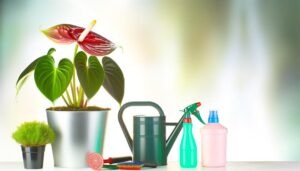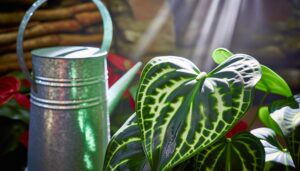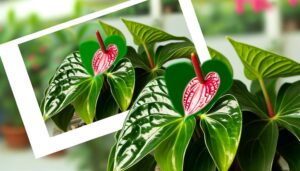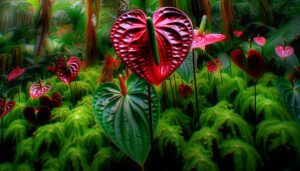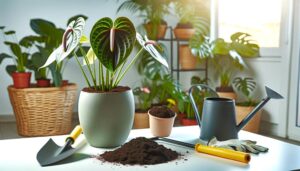Complete Guide to Caring for Your Anthurium Jungle King
Caring for your Anthurium Jungle King begins with bright, indirect light—avoid direct sunlight to prevent leaf scorch. Water when the top inch of soil is dry using room-temperature water and ensure good drainage.
A well-draining soil mix with orchid bark, perlite, and peat moss is essential. Maintain consistent temperatures between 70-85°F and 70-80% humidity.
Regular misting or a humidifier helps. Repot using a larger pot with drainage holes as needed, trimming any damaged roots.
Monitor for pests like aphids and spider mites, using neem oil if necessary. Look out for health issues like yellowing leaves or unusual spots.
Discover further techniques and care nuances.

Key Takeaways
- Provide bright, indirect light and avoid direct sunlight to mimic natural dappled light.
- Water when the top inch of soil is dry, adjusting frequency based on seasons.
- Use a well-draining soil mix with components like orchid bark, perlite, and peat moss.
- Maintain temperatures between 70°F to 85°F and ensure high humidity levels of 70-80%.
- Regularly inspect for pests and treat with neem oil or insecticidal soap if necessary.
Ideal Lighting Conditions

To ensure your Anthurium Jungle King thrives, place it in bright, indirect light, ideally avoiding direct sunlight that can scorch its leaves. This plant naturally grows under the canopy of tropical forests, so it’s adapted to dappled light. You’ll want to mimic these conditions by positioning it near an east or north-facing window.
If natural light isn’t sufficient, consider using a grow light to maintain prime photosynthesis. Too much direct sunlight can lead to chlorosis, where leaves lose their vibrant green color. Conversely, insufficient light will stunt growth and reduce flowering. A sheer curtain can diffuse intense light, creating the perfect environment.
Watering Schedule
To maintain your Anthurium Jungle King’s health, water it once the top inch of soil feels dry, typically once a week.
Overwatering can lead to root rot, indicated by yellowing leaves and a musty odor.
Adjust your watering schedule based on seasonal changes and humidity levels to prevent water stress.
Optimal Watering Frequency
You’ll need to water your Anthurium Jungle King when the top inch of soil feels dry, making sure the plant receives consistent moisture without becoming waterlogged. Use your finger to check soil dryness, and aim for a watering schedule of once every 7-10 days.
Adjust frequency based on ambient humidity and temperature; lower humidity or warmer temperatures might require more frequent watering. Always use room-temperature water to prevent shocking the roots. Ensure your pot has proper drainage to prevent root rot.
Water thoroughly until excess drains from the bottom, then empty the saucer to avoid standing water. By following these guidelines, you’ll provide the best hydration your Anthurium Jungle King needs to thrive without compromising its health.
Signs of Overwatering
Overwatering your Anthurium Jungle King often manifests as yellowing leaves, wilting, and root rot. These symptoms indicate that the plant’s roots are suffocating due to excess water. To prevent this, employ a consistent watering schedule and make sure the soil has good drainage.
Here’s a quick reference to help you identify signs of overwatering:
| Symptom | Explanation |
|---|---|
| Yellowing Leaves | Excess water disrupts chlorophyll production |
| Wilting | Roots can’t absorb oxygen, leading to stress |
| Root Rot | Fungal growth due to prolonged moisture |
| Moldy Soil | Excess moisture fosters fungal development |
Soil Preferences

For your Anthurium Jungle King, you’ll need a well-draining, aerated soil mix to prevent root rot and maximize growth. Incorporate components like orchid bark, perlite, and peat moss to achieve the ideal balance of moisture retention and air circulation.
Regularly check the soil’s drainage and adjust the composition as needed to maintain a healthy environment for your plant.
Ideal Soil Composition
Anthurium Jungle King thrives in a well-draining soil mix rich in organic matter, ensuring peak root health and nutrient uptake. To achieve this, you should create a blend that mimics its natural habitat. Aim for a mixture that’s light yet retains moisture without becoming waterlogged.
Here’s a precise recipe:
- Peat Moss (40%): Retains moisture and provides organic content.
- Pine Bark (30%): Enhances drainage and adds aeration.
- Perlite (20%): Improves soil structure and prevents compaction.
- Activated Charcoal (10%): Absorbs impurities and maintains freshness.
Drainage and Aeration
To maintain the best health of your Anthurium Jungle King, guaranteeing proper drainage and aeration is as crucial as the soil composition itself. Choose a well-draining mix, like a blend of orchid bark, perlite, and peat moss, to prevent waterlogged roots. Make sure the pot has drainage holes; excess water should escape easily.
Overly compact soil stifles root oxygenation, leading to rot. Mix in coarse materials to create air pockets, enhancing root respiration. Water thoroughly but let the soil dry out between waterings. This balance prevents fungal issues and promotes robust growth.
Temperature Requirements
Maintaining a consistent temperature between 70°F and 85°F is essential for the best growth and health of your Anthurium Jungle King. Fluctuations can stress the plant, potentially stunting its growth or causing leaf damage.
To ensure prime conditions, follow these guidelines:
- Avoid Cold Drafts: Keep your Anthurium away from windows or doors where chilly air might seep in.
- Consistent Warmth: Guarantee the room temperature doesn’t drop below 70°F, especially during nighttime.
- Steady Heat Sources: Use a thermostat-controlled heater if necessary, but avoid placing the plant directly adjacent to heat sources.
- Monitor Regularly: Use a dependable thermometer to check the temperature around your plant, adjusting as needed to maintain the ideal range.
Humidity Levels
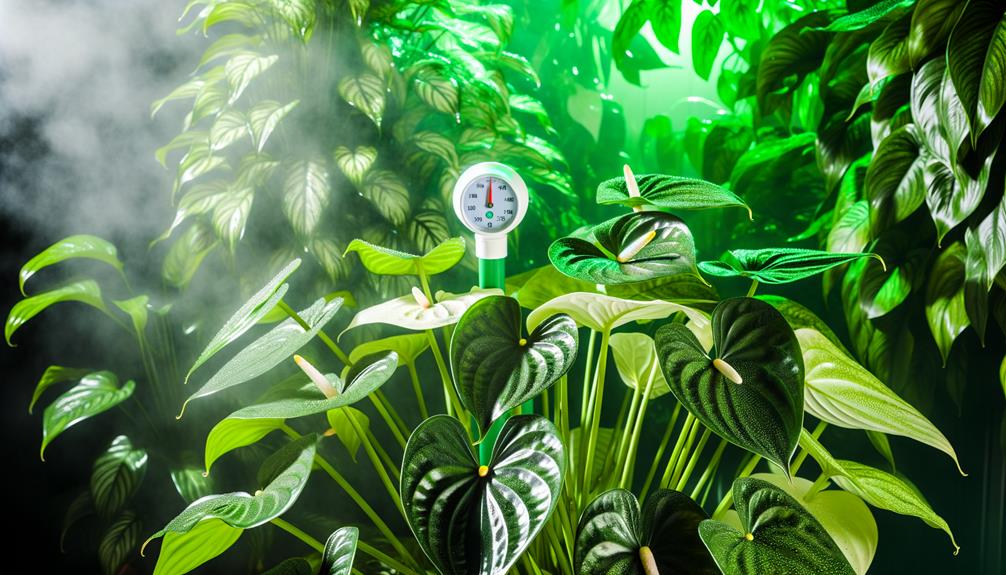
Proper humidity levels are essential for the Anthurium Jungle King‘s overall health and vibrant growth. Aim to maintain a relative humidity of 70-80%. This tropical plant thrives in moisture-rich environments, mimicking its natural habitat. Use a hygrometer to monitor indoor humidity.
If levels drop, consider using a humidifier or placing a tray of water near the plant. Mist the leaves regularly but avoid waterlogging the soil, which can lead to root rot. Grouping plants together can also help increase humidity through transpiration.
Additionally, placing the Anthurium in a bathroom or kitchen, where humidity from daily activities is higher, can be beneficial. Consistent humidity will support lush foliage and vigorous growth, ensuring your Jungle King remains a regal centerpiece.
Fertilization Tips
While maintaining peak humidity keeps your Anthurium Jungle King healthy, providing the right nutrients through proper fertilization is equally important for its vigorous growth.
Follow these steps to guarantee your plant thrives:
- Use a balanced, water-soluble fertilizer: Choose one with an N-P-K ratio like 20-20-20. This provides essential macronutrients.
- Dilute the fertilizer: Mix it to half the recommended strength to avoid root burn and excessive nutrient buildup.
- Fertilize during the growing season: Apply every 4-6 weeks from spring through early fall when the plant is actively growing.
- Flush the soil occasionally: Rinse with plain water to remove salts and prevent toxic buildup.
These steps help guarantee nutrient balance and promote robust growth in your Anthurium Jungle King.
Pruning Techniques

Pruning your Anthurium Jungle King is crucial for promoting new growth and maintaining its structural integrity. Start by using sterilized tools to prevent infections. Cut back dead or yellowing leaves, focusing on the base of the plant.
Trim any leggy stems to encourage bushier growth. Regular pruning not only enhances aesthetics but also improves airflow, reducing the risk of fungal infections.
Here’s a quick reference guide:
| Pruning Task | Purpose |
|---|---|
| Remove dead leaves | Prevent disease spread |
| Trim leggy stems | Promote bushier growth |
| Cut yellowing leaves | Enhance overall appearance |
| Sterilize tools | Prevent infections |
| Prune monthly | Maintain plant health |
Follow these steps to guarantee your Anthurium Jungle King thrives, offering you both beauty and freedom in your indoor garden.
Repotting Guide
After mastering pruning techniques, you’ll want to ensure your Anthurium Jungle King continues to thrive by repotting it every 1-2 years. Root-bound plants can hinder growth, so repotting is essential.
Follow these steps:
- Select a Pot: Choose a container 2 inches larger in diameter than the current one, making sure it has drainage holes.
- Prepare the Soil: Use a well-draining mix, perfect for epiphytic plants, combining orchid bark, perlite, and peat moss.
- Remove the Plant: Gently loosen the root ball and trim any damaged or rotting roots.
- Repot and Water: Place the plant in the new pot, backfill with soil, and water thoroughly to settle the roots.
Repotting preserves vitality and promotes vigorous growth.
Common Pests
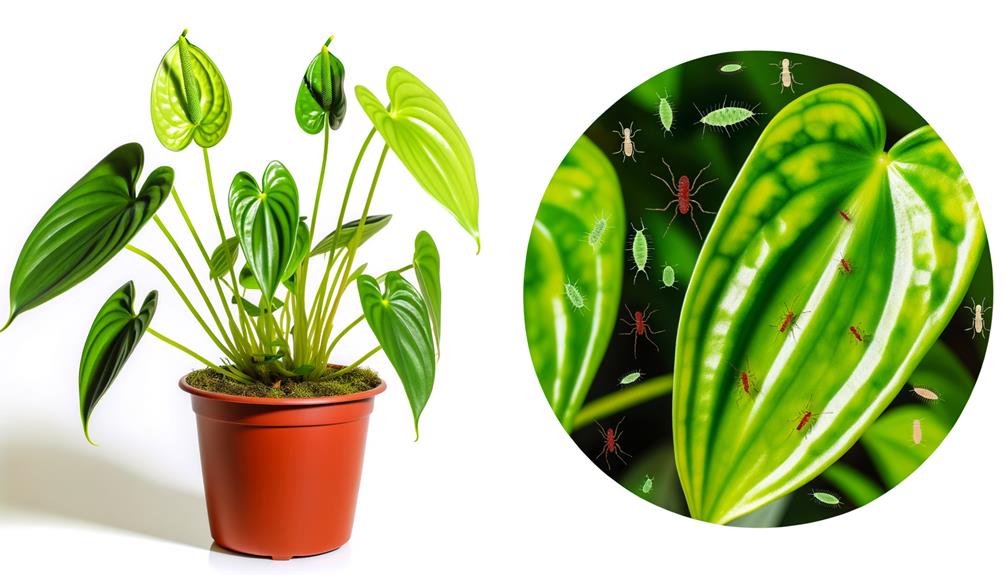
How can you protect your Anthurium Jungle King from common pests that threaten its health and peak performance?
Begin by monitoring for aphids, mealybugs, and spider mites. These pests feed on sap, leading to weakened foliage and stunted growth. Use neem oil or insecticidal soap as a first line of defense.
Ensure ideal humidity levels, around 60-80%, to deter spider mites, which thrive in dry conditions. Regularly inspect the undersides of leaves and new growth, where pests often hide.
Isolate any infested plants immediately to prevent the spread. A consistent watering schedule helps maintain plant vigor, making it less susceptible to infestation.
Signs of Health Issues
To identify health issues in your Anthurium Jungle King, look for symptoms like yellowing leaves, wilting, or unusual spotting. These signs could indicate various problems such as nutrient deficiencies, improper watering, or pest infestations.
- Yellowing Leaves: Often a result of overwatering or nutrient deficiency, particularly nitrogen.
- Wilting: Could be due to root rot from excessive moisture or underwatering.
- Unusual Spotting: Brown or black spots might signal fungal or bacterial infections.
- Leaf Curling: Typically caused by low humidity or pest attacks, like spider mites.
Regularly inspect your plant, and address these issues promptly to maintain its vibrant health. Your Anthurium Jungle King thrives on proper care, offering you lush, exotic foliage in return.
Conclusion
Caring for your Anthurium Jungle King doesn’t have to be difficult. By providing the appropriate lighting, watering schedule, soil, temperature, and humidity, you’ll guarantee your plant thrives.
Remember, an ounce of prevention is worth a pound of cure; stay vigilant for pests and health issues. Regular pruning and repotting will keep your Anthurium vibrant.
With these detailed guidelines, your Jungle King will reign supreme in your indoor garden, showcasing its stunning beauty and lush growth.


